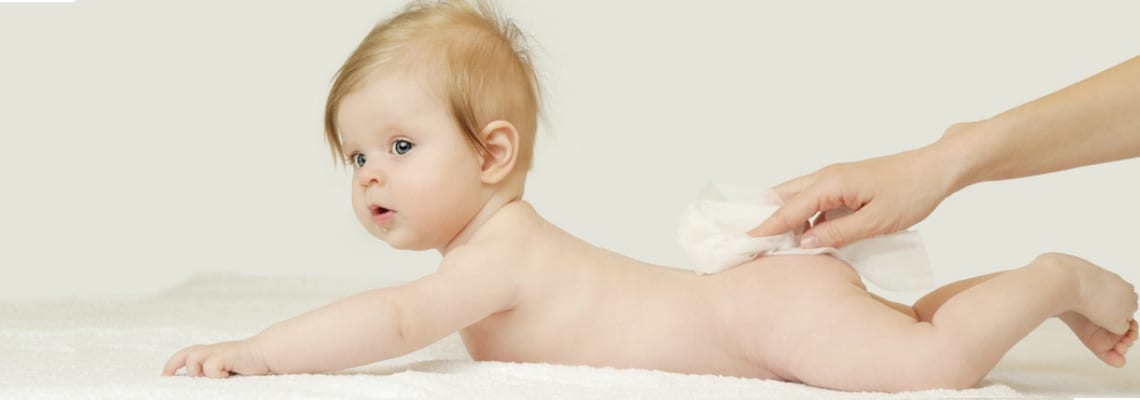
With pregnancy comes many decisions on how you will want to raise and take care of your baby. As you get closer to birth you are happily awaiting your new addition and trying to be as prepared as possible. One of the things you will want to decide on before the baby arrives is how you want to diaper them.
Many people have heard of reusable cloth diapers, but do not know much about them. There are advantages and disadvantages to both cloth or disposable diapers. We have put together a guide to help lay out the pros and cons of both.
The Basics
To break things down simply, disposable diapers are the most common type. These are the diapers you buy that you will just toss into the trash once they have been used. They come in many different brands, sizes, and costs.
A reusable diaper, or cloth diaper, are diapers that you wash in between uses. Cloth diapers come in many different forms, sizes, materials, and costs. Cloth diapers also come with many different accessories that may be required or just helpful, depending on the type of diaper you chose.
How much is this going to cost me? This is a huge concern for new parents. This is fully understandable, as babies can get expensive!
Disposable Diapers
Pro: You can purchase diapers as you need them. This will help keep your monthly costs down at home.
Con: However, in the long run you will spend more. Disposable diapers cost between 17 cents and 31 cents each. So if you assume that you will use around 60 diapers per week, that is an average of $62.50 per month, $750 per year, or $1,500 for two years in diapers.
Cloth Diapers
Pro: When it comes to money, cloth diapering will actually save you money in the long run. Buying cloth diapers for one child could cost around $300. The average family would need around six dozen cloth diapers. This can change depending on how often your little one uses the restroom and how often you wish to do laundry. If you assume that you will use your cloth diapers for at least two children, add on the cost of detergent and energy to wash your diapers at home, the total cost of cloth diapering one child would be around $450 for two years. This is an average of $18.75 per month or $225 per year.
**This cost could differ greatly depending on the types of cloth diapers you wish to use. There are cloth diapers that are as low as three dollars each to as high as 40 dollars each. This will depend on the material, style, and brand of diaper that you choose.**
Another amazing thing about cloth diapers is that you can reuse them on every child you have. The more children you plan on having, the more cloth diapering will save you. Plus, if they are still in good shape once you are done you might be able to re-sell them for around half of what you purchased them for.
Con: The biggest difference of cloth vs. disposable diapers is that cloth diapers will be more of an investment upfront than that of disposables. Cloth diapers can be a costly investment when you are first starting out.
 Disposable Diapers – It is estimated, in the United States alone, that 27.4 billion disposable diapers are being used. The actual advice found on the packaging of disposable diapers is that all fecal matter should be deposited in the toilet before discarding the diaper. However, less than half of one percent of all waste from disposable diapers actually goes into the toilet. More than 92 % of disposable diapers end up in a landfill. The exact amount of time that a disposable diaper would take to decompose is unknown, but it is estimated to take around 250- 500 years.
Disposable Diapers – It is estimated, in the United States alone, that 27.4 billion disposable diapers are being used. The actual advice found on the packaging of disposable diapers is that all fecal matter should be deposited in the toilet before discarding the diaper. However, less than half of one percent of all waste from disposable diapers actually goes into the toilet. More than 92 % of disposable diapers end up in a landfill. The exact amount of time that a disposable diaper would take to decompose is unknown, but it is estimated to take around 250- 500 years.
Disposable diapers are the third largest single consumer item that can be found in landfills. The use and manufacture of disposable diapers uses 2.3 times more wasted water than cloth diapers. More than 50 pounds of petroleum feedstocks, 300 pounds of wood, and 20 pounds of chlorine are used to produce disposable diapers for one baby each year.
Cloth Diapers – Reusable diapers are entirely environmentally friendly as they are not made from plastic. They can be used from 50 – 200 times before deteriorating. Parents who want to ensure that their children have a planet to grow up on usually decide to purchase items that will do more harm than good.
Cloth diapers come in many different eco-friendly fabrics such as bamboo and organic cotton. These both are soft, breathable, and comfortable for babies.
The most common reason for diaper rash is when there is excessive moisture within the skin. A baby should have their diaper changed every three- four hours. This is regardless if the diaper is reusable or disposable. A newborn may need their diaper changed more often than this.
Disposable Diapers – Disposable diapers are packed with chemicals such as polyethylene film, polypropylene, bleached wood pulp, sodium polyacrylate, and dyes such as Disperse Yellow 3 and Disperse Blue 106. These substances come into contact with a baby’s skin and then can be absorbed. These chemicals can cause diaper rash and other skin irritations in babies.
Cloth Diapers- Cloth diapers are free from chemicals and fragrances. Parents who want their children exposed to less harmful chemicals can see the appeal of cloth diapering. Transitioning to cloth diapers can help to reduce diaper rash if you have noticed a common occurrence within disposable diapers.
It is important to launder your cloth diapers will mild detergent to help ensure that the baby will not have a reaction to the detergent. When the diaper is wet, the plastic does not rub against their skin and cause it to be red, inflamed, or sore as a disposable diaper might.
Disposable Diapers – Disposable diapers contain traces of Dioxin, this is a toxic by-product of the paper bleaching process. This chemical is banned in most countries, but not the U.S. It is a carcinogenic chemical that is listed by the EPA as the most toxic of all cancer-linked chemicals. Disposable diapers have also been found to contain Tributyl-tin (TBT) that is a toxic pollutant that can cause hormonal issues within animals and humans.
The Archives of Disease in Childhood found that scrotal temperature is increased in boys that wear disposable diapers. They claimed that prolonged use of disposable diapers may blunt or completely abolish the physiological testicular cooling mechanism that is important for normal spermatogenesis.
Cloth Diapers – Cloth diapers allow for more breath-ability. The cotton helps to result in less skin irritation and rashes. Most cloth diapers are made using organic cotton. This is because farmers of non-organic cotton may spray their plants with chemicals or pesticides that could find their way into the material next to your baby’s skin. To avoid these chemicals it is best to look for organic cotton brands of cloth diapers.
The transition to potty training might seem like it is a long time away, but you might want to prepare for it now.
 Disposable Diapers – Transiting to potty training might take longer when using disposables. Disposable diapers tend to wick away the wetness after your infant has gone potty. This will keep them unaware of a wet diaper for a longer amount of time than a cloth diaper would. There is also the added expense of pull up style disposable training pants.
Disposable Diapers – Transiting to potty training might take longer when using disposables. Disposable diapers tend to wick away the wetness after your infant has gone potty. This will keep them unaware of a wet diaper for a longer amount of time than a cloth diaper would. There is also the added expense of pull up style disposable training pants.
When putting your child in underwear for the first time they will be discovering the new fabric and might not adjust as easily to the change.
Cloth Diapers – The transition to underwear is much easier when a toddler has been exposed to cloth diapers that are made of similar material. Cloth diapers tend to lead to earlier potty training for your infant. Reusable diapers allow them to feel the wet sensation against their skin. They can then become more aware of when they have gone potty. The transition to underwear will also be easier for cloth diapering parents as you are already used to laundering diapers when they are dirty.
Disposable Diapers- When it comes to overall ease, disposable diapers win out. Many parents find it simple to use the diaper once, toss it in the trash, and then never think about it again. The same goes for disposable wipes. Disposable diapers do not require the extra time and steps that cloth diapers do.
They are especially easier for on the go. Disposable diapers are smaller and more compact than cloth diapers, so you can fit more in your diaper bag.
While you are out and about you do not have to carry dirty diapers around with you (most of the time). There may be situations where you can’t toss used diapers at your location.
Cloth Diapers – Cloth diapers take more time and effort to maintain. You will need to purchase things such as wet bags to store your dirty diapers until you are ready to launder them. You will also need to decide if you are using reusable wipes or disposable. If you are using reusable wipes then you can toss them all into the same bag. However, if you choose to use disposable you will have to remember to toss them after each change.
You will need to launder and dry your cloth diapers usually one-three times a week. This depends on how many diapers you have and how many children are using them. Cloth diapers can also pose more of a challenge when it comes to traveling. If you do not have access to a washing machine, you will have to carry the dirty diapers with you for your trip and bring enough clean ones to last the amount of time that you are gone.
Overall cloth diapers will take more planning ahead, but it can be done easily if you are up for the challenge.
Helpful Tips for New Parents
Regardless of which option you take here are some tips to help make diapering your baby a little easier:
- Stock up – If you stock up on the things that you will need before baby arrives, this will help to avoid any last minute store runs! This means stocking up on diapers (cloth or disposable), wipes, diaper rash cream, and detergent if you are using cloth. Keep in mind if you are cloth diapering not all diaper rash cream can be used, you will need to do some research on which is best for the diapers you choose.
- Have a diaper station – Creating a diaper change station filled with whatever you might need will help make things easier. That means putting extra diapers, wipes, diaper cream, clothes, and a diaper pail nearby. This will help to keep baby safe while changing them.
- Be patient – Having a newborn is a learning curve, especially if you are not used to the diapering process. You will learn what works best for you after a while and things will get easier. This is even more the case if you are cloth diapering. It may seem very overwhelming at first, but with time you will get used to the process!
- Try new things – If something is not working for you, do not be afraid to mix things up! Say you try cloth diapering, but you have found it to be too time consuming and dirty for your liking. It is ABSOLUTELY okay to change your mind and go to disposables. The same goes for disposable diapers to cloth!

